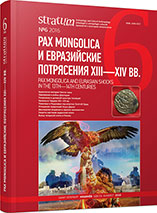Войны Улуса Джучи 50—70-х гг. XIII в. (европейское направление)
Wars of the Ulus of Jochi in 1250s —1270s (European direction)
Author(s): Yaroslav V. PylypchukSubject(s): History, Military history, Political history, 13th to 14th Centuries
Published by: Издательский дом Stratum, Университет «Высшая антропологическая школа»
Keywords: Ulus of Jochi; Poland; Hungary; Lithuania; Rus; Bulgaria; Byzantium; Mongol conquest; Nogai Khan; Daniel of Galicia
Summary/Abstract: This paper deals with the relationship of the Ulus of Jochi with countries in Central, Eastern and South-Eastern Europe in the 1250s — 1270s. The task of this article was to study the basic aspects of the Mongol invasions in Central Europe and the Balkans. The novelty of this study lies in the fact that the events are analyzed not within the history of any single country and not schematically as part of European regional history. The appearance of Nogay in the Balkans can be dated to the early 1270s. Throughout the 1250s, the attention of the Nogayans of Jochi’s Ulus was directed against Galicia-Volhynian State. Daniel of Galicia wanted to unite the land of Rus’. His campaigns were directed mainly against the Ruthenian allies of Noyon Kuremsa (Kurumyshi). Daniel of Galiciadid not invade the immediate possessions of the Golden Horde. Burunday set relatively mild conditions to surrender because he relied on use of the Rusyns in the campaign against the European neighbors of the Galicia-Volhynian state. Use of the allied forces (Rusyns and Bulgarians) as avant-garde was a characteristic feature of the Golden Horde’s campaign in Europe. Military operations in Poland and Lithuania led to local successes. The Mongols devastated the borderlands of Poland and got a few settlements. The Mongol campaign into Hungary in 1260 failed. Later, the Mongols used the Bulgarians to fight against the Hungarians.
Journal: Stratum plus. Археология и культурная антропология
- Issue Year: 2016
- Issue No: 6
- Page Range: 183-193
- Page Count: 11
- Language: Russian
- Content File-PDF

